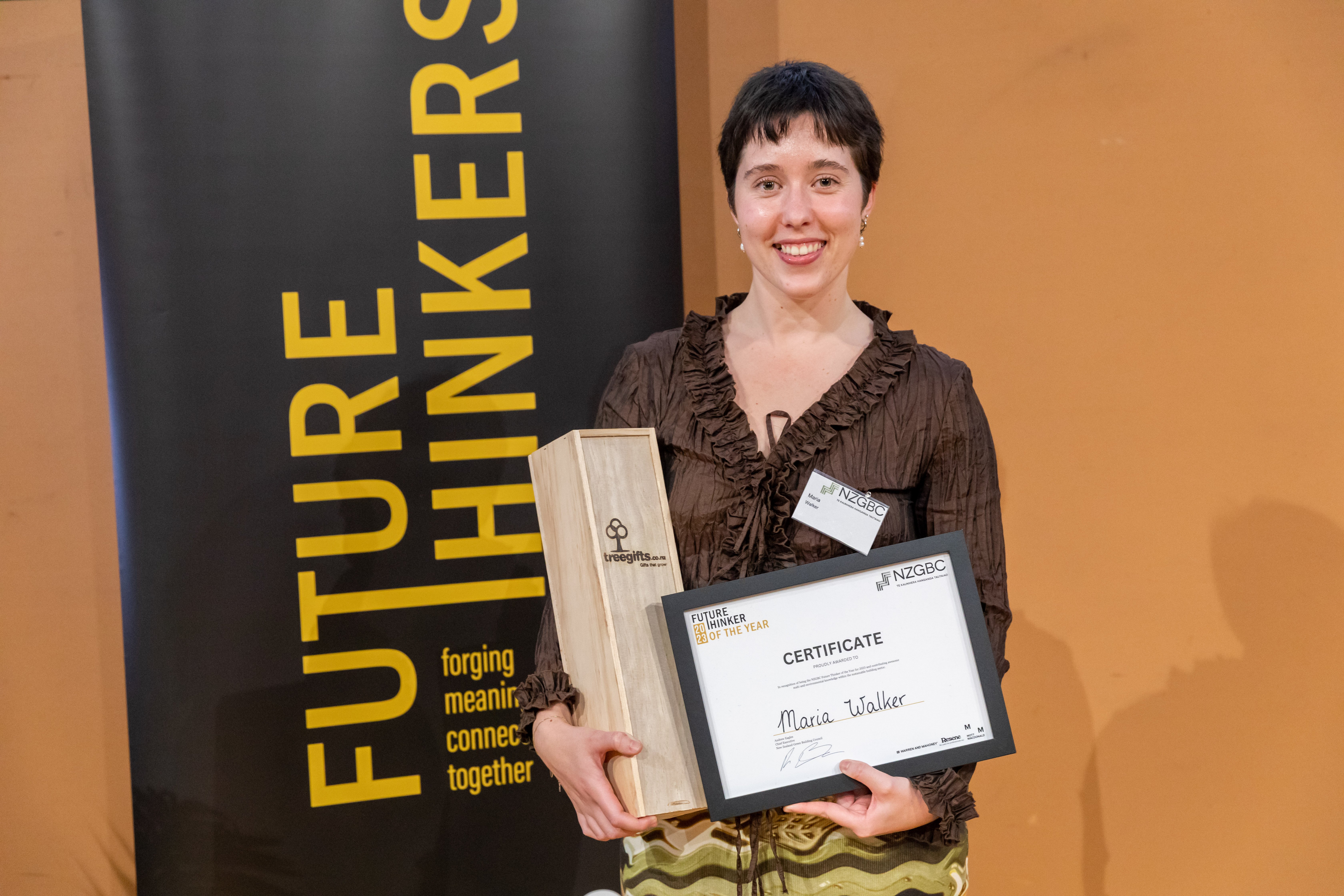Green Star Performance
Benchmarking the sustainable use of existing buildings

Helping benchmark the low carbon, sustainable operations of existing buildings
Since the introduction of Green Star in 2007, the NZGBC has been successful in certifying over 250 new buildings and fitout projects in New Zealand. While this is an outstanding achievement, there are thousands of buildings already in use that have a key part to play in reducing emissions for a low carbon future.
A Green Star Performance rating helps building owners measure and continually improve their buildings' operational performance and reduce emissions.
What makes a Green Star building?
Green Star is a holistic tool that awards points across various key performance and environmental categories to assess how sustainable a building is.
For Green Star Performance, ratings are awarded from 0-6 stars, with 2 stars considered average practice, 3 stars good practice, through to 6 stars demonstrating a world leading green building.
Unlike other Green Star tools, a Green Star Performance rating is temporary, lasting three years, with an annual requirement to submit energy and water data. This ensures the rating is an accurate assessment of operations at the time, and allows building owners and tenants to improve their star rating over time.
Green Star - Performance assesses the operational performance of all types of existing buildings across nine holistic impact categories.

Emissions
Aims to assess the environmental impacts of 'point source' pollution generated by buildings to the atmosphere and local waterways, such as stormwater, refrigerant leakage, and light pollution..

Energy
Aims to reward buildings that reduce greenhouse gas emissions associated with energy by being energy efficient, reducing energy peak demand, and using generation from alternative sources. This is a mandatory requirement.

Indoor environment quality
Looks at different indoor environment metrics to reward spaces that support the comfort and wellbeing of occupants, such as air quality, thermal comfort, acoustic comfort, and occupants’ satisfaction surveys.

Innovation
Aims to recognise the implementation of innovative practices, processes and strategies that promote sustainability during the operational phase of a building.
Land use and ecology
Aims to reward efforts to enhance the ecological value of the site and best-practice groundskeeping practices.

Materials
Aims to reward initiatives that reduce operational and refurbishment waste generated in the building, rewarding operations that have a higher diversion rate from landfill. This credit also rewards the use of sustainable procurement policies for consumables and refurbishment materials.
Transport
Aims to reward initiatives and building features, such as end-of-trip facilities, that encourage visitors and occupants of a building to use lower-carbon, more environmentally friendly transport options.
Water
Aims to reward initiatives that measure, monitor, and reduce the consumption of potable water with may include water efficient fixtures and water re-use. This is a mandatory requirement.Technical resources
Here you'll find everything you need to guide you through your Green Star certification.
Please note, these documents are for the latest version introduced in April 2022 - Green Star Design & As Build NZ v1.1
If you're project was registered under a previous version of Green Star you can continue to use the submission guidelines and resources associated with that version. Previous versions, including Design & As Built v1.0 can be found here.
Please note, Microsoft often blocks macros on downloaded documents. In order to access the full calculator functionality macros needs to be enabled. Macros and adding the document as a trusted file can be done when the document is first downloaded or through the file's security properties. Find out more here
Green Star recognises innovation and efforts to carve out new ways of building sustainably. Often these sit outside the current benchmarks laid out in the tool, however points are awarded under a seperate 'Innovation' credit. This recognises new initiates with a significant sustainability benefit.
Each project can submit up to 10 innovations to be considered for approval, for a maximum of 10 points towards a Green Star rating.
If you have an idea for an innovation in your project, we encourage you to talk to us as early in the process as possible.
1. After reviewing the section for Innovation in the Green Star Submission Guidelines, your Green Star Accredited Professional will then need to registers a project’s interest in targeting an Innovation with the NZGBC.
2. You will then need to submit a completed Innovation submission using the template below. This outlines the initiative, its sustainability benefits and relevance in New Zealand.
3. Documentation will then need to be submitted for assessment after registration but before Round Two).
Project teams can provide partial documents or full documents in a 'Pre-Round One' or 'Pre-Round Two' review for each proposed innovation. If the innovation is granted conditionally pending further documentation, all the remaining documents need to be provided in either Round One or Round Two assessment. Innovations can't be targeted after Round Two.
In addition to innovations claimed by projects, both Green Star and Homestar have published a list of innovation challenges. These recognise initiatives that don’t currently fit in to the main framework of these tools but that we believe are important to encourage and recognise. They cover environmental, social and economic sustainability initiatives. While some challenges only apply to some tools, others across all our tools. Several current innovation challenges were originally published by the Green Building Council of Australia for Green Star projects there, but have been adapted for Green Star and Homestar projects in New Zealand.
Click here to go see the Table of Innovation Challenges
You are welcome to submit a new challenge relating to sustainability issues you would like to address
The submission template is developed to assist your project with an innovation submission – these will be submitted to us by your Green Star Accredited Professional (GSAP)
We’ve already recognised some incredible New Zealand buildings for innovative design and strategies.
These submissions, from NZGBC’s own office fit-out, will give you an idea of what NZGBC expects.
Lorem ipsum dolor sit amet consectetur adipiscing elit dolor semper at ac tempus enim. Nam sollicitudin ex vitae mauris eleifend lobortis tincidunt nec orci. Vestibulum sollicitudin leo eu auctor porttitor. Suspendisse in porta nunc. Curabitur vel pulvinar sem.
Nullam auctor dolor erat, a dictum nisi commodo vitae.
Green Star- Performance Eligibility & Registration Form
Green Star – Performance Certification Timeline Diagrams
Green Star - Performance v1.2 Scorecard Single Building
Please contact Green Star Performance team to get a scorecard for portfolio projects. Note that requests for a Performance Portfolio scorecard must include the portfolio's performance period and completed asset list
Green Star - Performance Submission Templates
Green Star Performance folder structure
8 Indoor Air Quality Calculator v1.2 r2
10 Lighting Comfort Calculator v1.2 r3
11 Daylight and Views Calculator v1.2 r2
Calculator guide - Daylight and Views hand calculation
12 Thermal Comfort Calculator v1.2 r2
13 Acoustic Comfort Calculator v1.2 r2
14 Occupant Satisfaction Calculator v1.2 r2
15A ENE GHG Emissions Calculator v1.2 r10
15B ENE GHG Emissions Calculator v1.2 r3
15B PORTFOLIO GHG Energy Calculator v1.2 R1
15C ENE GHG Emissions Calculator v1.2 r10
15D ENE GHG Longitudinal Benchmarking Calculator v12 r11
Calculator guide - GHG Calculation v1.2
16A ENE Peak Electricity Demand Calculator v1.2 r2
16B ENE Peak Electricity Demand Calculator v1.2 r2
16C ENE Peak Electricity Demand Calculator v1.2 r2
17 TRA Sustainable Transport Program Calculator v1.2 r3
18 TRA Transport Modes Calculator v1.2 r2
19A WAT Potable Water Calculator v1.2 r13
19B WAT Potable Water Calculator v1.2 r1
Calculator guide - Potable Water calculation
19B PORTFOLIO Potable Water Calculator v12 r1
19C Potable Water Peer Group Calculator v12 r9
19D WAT Potable Water Calculator v1.2 r7
21 MAT Procurement and Purchasing Calculator v1.2 r2
22.2A MAT Waste from Operations Calculator v1.2 r8
22.2B MAT Waste from Operations Calculator v1.2 r7
22.2C MAT Waste from Operations Calculator v1.2 r7
23 MAT Waste from Refurbishments Calculator v1.2 r2
Green Star recognises innovation and efforts to carve out new ways of building sustainably. Often these sit outside the current benchmarks laid out in the tool, however points are awarded under a separate 'Innovation' credit. This recognises new initiates with a significant sustainability benefit.
Each project can submit up to 10 innovations to be considered for approval, for a maximum of 10 points towards a Green Star rating.
If you have an idea for an innovation in your project, we encourage you to talk to us as early in the process as possible.
How to claim Innovations
-
After reviewing the section for Innovation in the Green Star Performance Submission Guidelines (available to members and Green Star professionals below), please inform the NZGBC if you are intending on targeting an innovation.
-
You will then need to submit a completed Innovation submission using the template below. This outlines the initiative, its sustainability benefits and relevance in New Zealand.
-
Documentation will then need to be submitted for assessment after registration but before Round Two).
Project teams can provide partial documents or full documents in a 'Pre-Round One' or 'Pre-Round Two' review for each proposed innovation. If the innovation is granted conditionally pending further documentation, all the remaining documents need to be provided in either Round One or Round Two assessment. Innovations can't be targeted after Round Two.
Innovation Challenges
In addition to innovations claimed by projects, both Green Star and Homestar have published a list of innovation challenges. These recognise initiatives that don’t currently fit into the main framework of these tools but that we believe are important to encourage and recognise. They cover environmental, social and economic sustainability initiatives. While some challenges only apply to some tools, others across all our tools. Several current innovation challenges were originally published by the Green Building Council of Australia for Green Star projects there, but have been adapted for Green Star and Homestar projects in New Zealand.
Table of Innovation Challenges
You are welcome to submit a new challenge relating to sustainability issues you would like to address
Submission Template
The submission template is developed to assist your project with an innovation submission – these will be submitted to us by your project team.
Financial Transparency Disclosure Template
- Download
NZGBC Members and Green Star Accredited Professionals can access the Submission Guidelines for free.
For non-members the Submission Guidelines please contact the team to purchase.
Login, or get in touch
Certification fees
Green Star Performance
For a Green Star Performance Certified Rating, the following fees apply.
Please note price will be determined at time of billing and is subject to change. The certification fee is payable in full upon registration, as well as before Year 1 and Year 2 Audits in Green Star Performance. All fees shown are excluding GST.
| Annual Fee | Members | Non Members |
|---|---|---|
| 1st building | $6,900 | $9,430 |
| Additional buildings up to and including the 10th, fee per building | $1,500 | $1,849 |
| Additional buildings from the 11th project, fee per building | $600 | $700 |
| Technical questions | $400 | $400 |
Energy and Water only
For those targeting the energy and water only pathway for Green Star Performance fees differ.
Please note price will be determined at time of billing and is subject to change. The certification fee is payable in full upon registration, as well as before Year 1 and Year 2 Audits in Green Star Performance. All fees shown are excluding GST.
Annual fee |
Members |
Non
|
1st building |
$4,150
|
$5,500
|
Additional buildings up to and including the 10th, fee per building |
$575
|
$690
|
Additional buildings from the 11th project, fee per building |
$150
|
$300
|
Additional fees for Green Star Performance Certifications
Charged technical question - $400 + GST
Charged additional review - $975 + GST
Appeal - $975 + GST
Extension of time fee - $3,000 + GST
Certification Agreement amendment - A minimum of $200 subject to the complexity of the required changes.
Benchmark office energy use
While Green Star Performance offers a holistic, comprehensive benchmark of building operations, NABERSNZ is a trusted, industry-recognised tool for benchmarking energy use exclusively in office buildings.








































